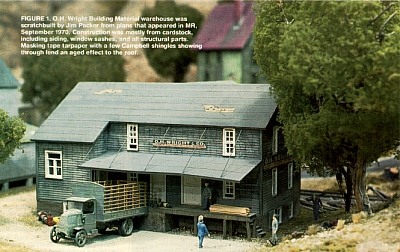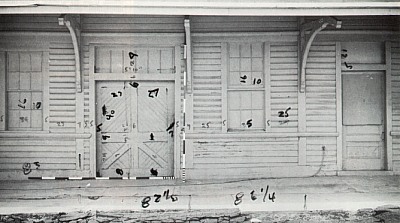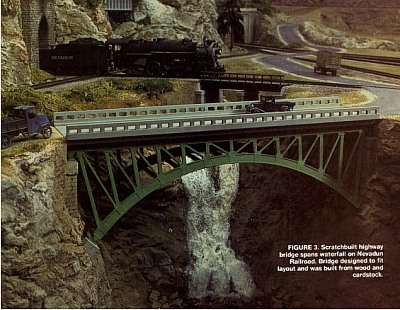
Earning an Achievement award for modeling structures requires basically two things: you must build some models, and be willing to let somebody look at them. Perhaps that is an over- simplification of what appears on the surface to be a big challenge, but that just about covers it.
Let's look at these two steps. The basic requirements call for 12 scale structures of six different types, with at least one bridge or trestle and at least six scratchbuilt. The others must be detailed with scratchbuilt or commercial parts.
Perhaps you are fearful over the thought of building six structures that didn't start out in a box. Don't let it overwhelm you. After all, the award is for construction, not architecture! Every month there are articles in the model magazines, accompanied by detailed plans for houses, water tanks, bridges, trestles, coal towers, city buildings, railroad structures and on-line industries. That's over six different types already If the drawings are the same scale you model, take the magazine to a copy machine and make several copies of each drawing. If the drawing is not in your scale, find a copier that enlarges and reduces. Make a trial size, check the result with your model railroad scale ruler, and adjust the size as needed.
You can use these copies to cut and assemble your model. Sometimes it even works to glue your materials directly onto the copied plans and then cut the paper away around the edges before assembling the components.
The main difference between scratchbuilding and building craftsman kits is the origin of the plans and the materials (Figure #1).
 Figure #1
Figure #1
Perkins Produce on Jim Packer's Nevadun Railroad in Bedford, Texas. The scratchbuilt model features individual clapboard siding and sandpaper composistion roof. Plans appeared in MR, December 1974.

O. H. Wright Building Material warehouse was scratchbuilt by Jim Packer from plans that appeared in MR, September 1970. Construction was mostly from cardstock, including siding, window sashes, and all structural parts. Masking tape tarpaper with a few Campbell shingles showing through lend an aged effect to the roof.
MMR Alan Means recommends a measuring pole be included when photographing a structure you plan to model.
This technique is especially useful when modeling a structure you will include for the Master Builder Prototype Models certificate. The pole (mahogany is best) is a 1" x 2", either a 12-footer or two 6-footers held together using bolts and wing nuts 6 inches from the end-making it then 11 feet long, but collapsible for easier transport. The pole is marked in 1-foot stripes, alternately painted black and white. The last foot is marked in inches, painted alternately black and white. Simply secure the pole flat against the structure and shoot the pictures, either black-and-white or color prints (Figure #2). Continue around the building, overlap a section in your picture so you don't miss anything. Enlargements will be easier to use for measurements.
 Figure #2
Figure #2
Alan Means uses a measuring pole in his photographs as a gauge for measuring prototype buildings for scratchbuilding a model. Only one pole is necessary.
Obviously, a working knowledge of model assembly is essential. First start with simple kits, add some details and weathering. Next, advance to a craftsman type kit, then add a few extras. Once you are comfortable with kit construction, go for the gusto! Scratchbuilding is a rewarding challenge, creating a structure unique to your need, and it may save you a lot of money.
Now let's take those kit built structures you plan to submit for judging and dress them up a bit more. Use your imagination. Look at a 12-inch-to-the foot structure for ideas. Realism is the key.
There are soft metal castings, etched brass and plastic parts available for detailing. Try adding nut, bolt-and-washer castings to your bridge. On rooftops put vents and other typical items. How about downspouts and gutters? Add electric meters to a back wall. Perhaps a lattice on the side of a house for roses to grow br ivy on a brick wall. Change things; add a hand-laid shingle roof instead of the kit one. Check your scrap box for extra pieces to add.
Remember that this award is for structures, not displays, so it's not necessary to mount your structure or add anything around it.
Bob Gardner, MMR, who has many merit and prize-winning awards, offers these suggestions ... reverse kit plans and alter the building size. Pre-stain all lumber before assembly Remove any glue spots after assembly. The 'glue gremlin' is a common problem where you will lose valuable construction points. For the roof, try emery cloth, weathered with pastel chalk dust. Be sure to add several signs, placards and posters, sand some, then use a thin black wash to weather.
Weathering is critical, like soot and rain stains, variations in sun bleaching and aging, distress the wood, crack a window, add a roof patch, brick up a window, remove some shingles, and don't forget some graffiti.
On the contest form or your AP application, be sure to include small or unique features, extra details and odd materials used, which the judges might overlook (Figure #3).
 Figure #3
Figure #3
Scratchbuilt highway bridge spans waterfall on Nevadun Railroad. Bridge designed to fit layout and was built from wood and card stock.
Now that you have your model built, show it to others. If the comments are constructive, use this to your advantage. Try to fix up the model to improve your score.
Earning an Achievement award requires that you do a little writing. If you have a standard NMRA contest entry form, that would be the best way to do it. Just fill out the form, explaining in each section what you have done and how you did it. Be precise and thorough. Many models have failed to score well in contests because the entry form wasn't complete.
Although it is not mandatory to enter contests, it is encouraged. It is a learning experience. You don't have to get a ribbon (which would be nice) to get a merit award. You're looking for 871/2 points out of 125, a 70 percent passing grade. The members selected to judge your work will be fair, consistent in scoring all models (per judge), and will respect your craftsmanship.

Three scratchbuilt models and one detailed Campbell kit are featured in this scene on Jim Packer's Nevadun Railroad.
In addition to seeing your name in the BULLETIN, you will receive your certificate at a general meeting or convention, or it will be mailed if you prefer.
Now you are a Master Builder-Structures. That has a nice ring to it, doesn't it!